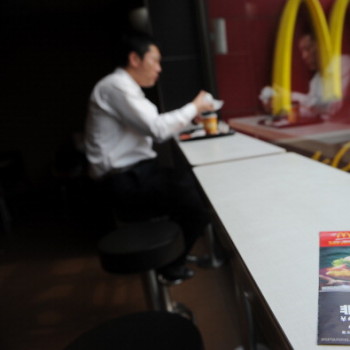While what ingredients to put in a lunchtime wrap might seem like a small decision to you, when it’s McDonald’s picking out vegetables it has major impact. When the world’s largest fast food chain launched their “McWrap,” they decided to include fresh cucumbers – an item not previously included in any of their recipes – and that meant ordering up over six million pounds of the green things from suppliers. And while that fact alone might be impressive, it’s just the beginning of the company trying to stake out a position in the coming “Fresh Wars.”
Susan Berfield recently penned a feature for Bloomberg Buisnessweek about the “Fresh Wars” – fast food chains appealing to younger customers seeking foods that at least seem healthier – and what it means for the food economy at large. She joined us to talk about transparency, evolution, and yogurt.

Brendan Francis Newnam: To get a sense of the size and power of McDonald’s, I thought it would be nice if you started by telling me about the ripple effects of McDonald’s decision to put cucumbers in the McWrap.
Susan Berfield: So McDonald’s estimates that this year, they’re gonna use about six million pounds of these cucumbers, and that’s not even for a full year of sales, right?
The McWrap was launched in April, so if all goes well, the suppliers are gonna to be supplying McDonald’s with probably, you know, millions and millions of pounds of cucumbers.
Brendan Francis Newnam: So it’s great for cucumber farmers and the entire cucumber species.
Susan Berfield: Yes
Brendan Francis Newnam: What are some other numbers that demonstrate the scope of McDonald’s these days?
Susan Berfield: It is the biggest restaurant chain in the world by sales. There are 14 thousand restaurants in the U.S. alone. 69 million people eat at McDonald’s every day. And, in the US more people went to McDonald’s than to any other store of any other kind.
Brendan Francis Newnam: Well, it sounds like things are going well, so why the McWrap?
Susan Berfield: You know, McDonald’s is looking ahead, and they see that the younger generation – they call them Millennials, but you can say people in their 20’s – want food that is fresh, or seems fresh. That’s healthy or seems healthy.
Brendan Francis Newnam: Yeah, I like this part. You talk about the “Fresh Wars.” Is like the cola wars? Is it? Tell me about the fresh wars.
Susan Berfield: This is it. You know, there’s a lot of chains that are doing really well, and some of them like Subway, like Chipotle, make a show of making the food in front of you. You get to order, you get to pick. McDonald’s obviously is not set up that way. At all.
Brendan Francis Newnam: No.
Susan Berfield: The opposite.
Brendan Francis Newnam: You just point and say number four.
Susan Berfield: I want that, and I want three of them, and I want it in a minute. And then I’m gonna go eat in my car.
Brendan Francis Newnam: Yeah.
Susan Berfield: Right? Because 65% of McDonald’s customers order through the drive-thru. So, it’s an entirely different mindset, and it was set up to be an entirely different thing. But McDonald’s does evolve, right? I mean, they sell salads, they sell yogurt.
Brendan Francis Newnam: So basically what you’re saying is, it wasn’t like a chef was like, “Hmm, I think we knew chicken wrap on the menu.”
Susan Berfield: No, no it wasn’t. They are very, very careful at McDonald’s. And that’s because of their size. You know, when something goes wrong, it goes wrong in a very big way. And when something goes right, it goes right in a very big way.
Brendan Francis Newnam: That’s interesting. Before we go any further, I brought a McWrap. Now, you and I know that we’re recording this interview in the morning, and they don’t sell McWraps in the morning.
Susan Berfield: How did you get it?
Brendan Francis Newnam: I got this yesterday leaving the office. I got two of them so I could eat one, because I do my due diligence.
Susan Berfield: I see one’s gone, that’s right. Alright. What’d you think?
Brendan Francis Newnam: What did I think? I thought it was, meh.
Susan Berfield: Yeah.
Brendan Francis Newnam: There was nothing really too flavorful about it, but I will tell you as we look at this, this container is super cool. This, it looks like a mini poster tube with like a cardboard zipper. What’s the story behind this thing? I’m gonna open it just so we can look.
Susan Berfield: There you go. McDonalds-
Brendan Francis Newnam: Wow.
Susan Berfield: Yeah, McDonald’s is also very excited about that packaging.
Brendan Francis Newnam: Well I mean it’s better than what’s in it.
Susan Berfield: Yeah, that was developed in Austria, yep.
Brendan Francis Newnam: Wow.
Susan Berfield: And, in about 2009, and I think that was one of the reasons McDonald’s in the US thought that they could make a go of it, because when they saw that packaging, they’re like, that is kind of fun.
Brendan Francis Newnam: Also, according to your article, this packaging was designed to fit into a car cup holder.
Susan Berfield: Absolutely.
Brendan Francis Newnam: So you could eat this while driving your SUV, texting, and you could just put that in your cup holder without compromising the integrity of your wrap.
Susan Berfield: That is the point. As we said, McDonalds’s, 65% of their customers order in the drive-thru, and then we presume they eat in the car, right? So, the more portable something is, and if you can eat it with one hand, all the better, right?
Brendan Francis Newnam: Yeah.
Susan Berfield: And guess what? You can’t do that with Chipotle.
Brendan Francis Newnam: Oh, interesting.
Susan Berfield: Don’t think McDonald’s didn’t think about that.
Brendan Francis Newnam: Oh yeah. So, they obviously thought long and hard about this product. How’s it doing?
Susan Berfield: You know, McDonald’s doesn’t often give the sales for specific items. And I say often because the assumption among people who pay real close attention to McDonald’s and their sales figures is that, if it were doing extraordinarily well, McDonald’s would want to say so, right?
Brendan Francis Newnam: Sure.
Susan Berfield: You know, salads have been on the menu at McDonald’s for years, but the CEO recently told everyone that salads only account for about 2% of McDonald’s sales.
Brendan Francis Newnam: Oh my goodness.
Susan Berfield: So, you know, McDonald’s keeps them on the menu. They’re never going to get rid of salads, but you know, they’re selling fewer kinds of salads.
Brendan Francis Newnam: So a veggie-laden wrap might not help their bottom line, but as you explained to your article, even if the McWrap fails as a food item, it can still succeed as a marketing tool.
Susan Berfield: It has a symbolic value. Consumers of all kinds want choice. So, if McDonald’s is offering something healthier and consumers don’t choose that, you still pick a Big Mac and fries even though you could have the grilled McWrap, then people don’t blame McDonald’s.
Brendan Francis Newnam: Very clever. It inoculates them from criticism that they don’t have healthy options.
Susan Berfield: Absolutely. It’s there. You made a, we won’t say “bad” choice… you made a different choice.
Brendan Francis Newnam: So, even if this goes the way of the Arch Deluxe, the McHotDog, and some of these other classics, it’ll maybe help their McImage.
Susan Berfield: I think so. I think that’s what they’re hoping.


